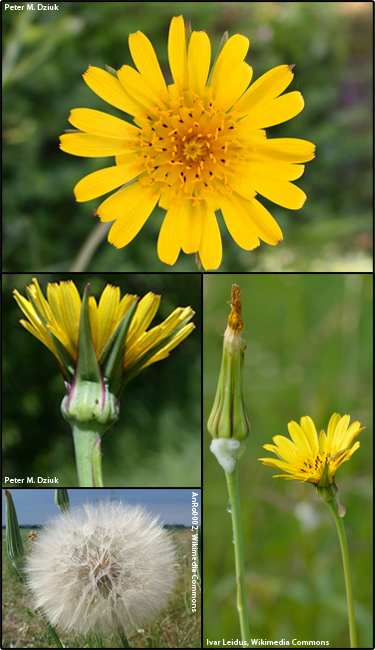Jack-go-to-bed-at-noon (Tragopogon pratensis)
 Synonyms: Tragopogon lamottei, Tragopogon orientalis, Tragopogon pratensis ssp. orientalis
Synonyms: Tragopogon lamottei, Tragopogon orientalis, Tragopogon pratensis ssp. orientalisCommon Names: Meadow goat's beard, common goat's beard
Description: In Michigan, the earliest known observation was in 1880.
Habit:
Leaves: Grass-like blades, 3/4 in wide and 12 inches long, becoming smaller up the stem, toothless, generally smooth, waxy, sparse hairs when young, narrow near the base, tapper to a pointed tip, clasping, curved.
Stems: Slightly swollen below flowerhead, smooth, green in color or whitish, branching near the base or with multiple flowering stems.
Flowers: Solitary, 1-2.5 inches across, yellow in color, many dandelion-type petals, 8 or more green bracts surround the flower.
Fruit and seeds: Dandelion-type plume, 3 inches across. Seeds are brown in color with a tuft of whitish hairs.
Habitat: Native to Europe. Can be found in roadsides, disturbed sites, waste places, and fields.
Reproduction: By seed.
Similar species: Yellow salsify (Tragopogon dubius)
Monitoring and rapid response: Can be controlled by cultivation, hand pulling or with several readily available general use herbicides. Credits: The information provided in this factsheet was gathered from Minnesota Wildflowers and the University of Wisconsin-Madison Horticulture Extension.
Individual species images that appear with a number in a black box are courtesy of the Bugwood.org network (http://www.invasive.org).Individual photo author credits may not be included due to the small display size of the images and subsequent difficulty of reading the provided text. All other images appear courtesy of Google (http://images.google.com).
Common Name: | Jack-go-to-bed-at-noon |
Scientific Name: | Tragopogon pratensis |
Family: | Asteraceae (Aster) |
Duration: | Biennial |
Habit: | Herbs |
USDA Symbol: | TRPR |
